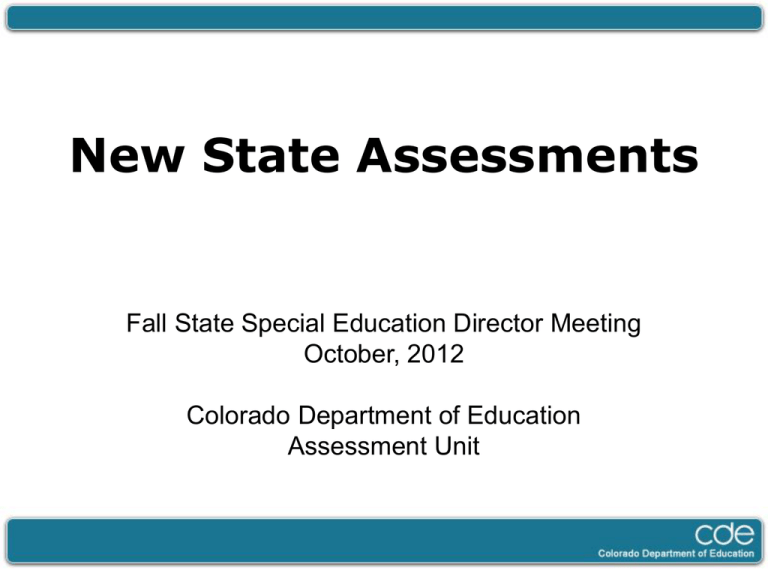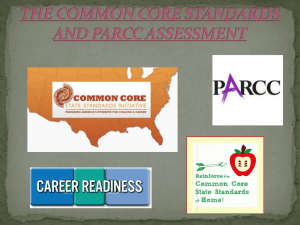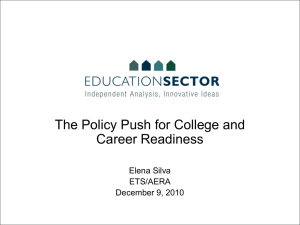New State Assessments
advertisement

New State Assessments Fall State Special Education Director Meeting October, 2012 Colorado Department of Education Assessment Unit Advance Organizer • Timeline • New English Language Arts and Mathematics Assessments with Partnership for Assessment of Readiness for College and Careers (PARCC) • New Science and Social Studies Assessments • New English Language Proficiency Assessments • Update on the Colorado Content Collaboratives Summative Assessment Timeline 2013 • TCAP and CoAlt Continue • Colorado ACT Continues • ACCESS administered to assess English language proficiency 2014 • TCAP and CoAlt Reading, Writing and Math Continue • New Social Studies and Science assessments are expected to be operational • Colorado ACT Continues • ACCESS Continues 2015 • New English Language Arts and Mathematics assessments (PARRC) • Second year of new operational Social Studies and Science assessments • Colorado ACT Continues • ACCESS Continues English Language Arts and Mathematics • Recent legislation – Requires Colorado to participate as a Governing Board member in a consortium of states that focuses on the readiness of students for college and careers. – Requires the Board to rely upon the assessments developed by the consortium expected to be ready for spring 2015. – Encourages the Board to conduct a fiscal and student achievement benefit analysis of Colorado remaining a Governing Board member starting on or before January 1, 2014. PARCC • Colorado joined PARCC as a governing member in August 2012. • English Language Arts and Mathematics in grades 3-11 • Computer-based (Paper-Pencil version expected) • First operational assessment: spring 2015 PARCC States PARCC Governing States • Approve test specifications, priorities for content assessed on each component, and recommended scoring model • Develop long-term sustainability plans for the consortium and assessment system, including through design of the tests and ability to refresh over time • Approve solicitations and select vendors for PARCC procurements • Determine highest priority model instructional tools for PARCC to develop PARCC Governing States (Continued) • Build and expand cadres of K-12 educators and postsecondary faculty leading standards implementation and PARCC assessment development • Ensure the assessment results provide the data needed to support state accountability mechanisms and educator evaluation model – Participate in technical & policy working groups on accountability to help identify solutions to pressing accountability transition challenges and new approaches to accountability through ESEA waivers PARCC Assessment Design 2 Optional Assessments/Flexible Administration Diagnostic Assessment •Early indicator of student knowledge and skills to inform instruction, supports, and PD Mid-Year Assessment •Performancebased •Emphasis on hard-tomeasure standards •Potentially summative Performance -Based Assessment (PBA) •Extended tasks •Application s of concepts and skills •Required End-of-Year Assessment •Innovative, computerbased items •Required Speaking And Listening Assessment • Locally scored • Non-summative, required PARCC Goal: Build a Pathway to College and Career Readiness for All Students K-2 formative assessment aligned to the PARCC system K-2 Timely student achievement data showing students, parents and educators whether ALL students are on-track to college and career readiness 3-8 College readiness score to identify who is ready for college-level coursework High School ONGOING STUDENT SUPPORTS/INTERVENTIONS Targeted interventions & supports: •12th-grade bridge courses • PD for educators SUCCESS IN FIRST-YEAR, CREDIT-BEARING, POSTSECONDARY COURSEWORK PARCC Assessments • In English Language Arts/Literacy, intended to answer whether students: – Can read and comprehend complex literary and informational text – Can write effectively when analyzing text – Have attained overall proficiency in ELA/literacy Reading and writing grounded in evidence from text, literary and informational. PARCC English Language Arts • rewards careful, close reading • systematically focuses on the words that matter most, the academic language that pervades complex texts • focuses on students rigorously citing evidence from texts • includes questions with more than one right answer to allow students to generate a range of rich insights that are substantiated by evidence from text(s) • requires writing to sources • includes rigorous expectations for narrative writing as well • assesses not just ELA but a full range of reading and writing across the disciplines • simulates research on the assessment English Language Arts • Item Types: • Evidence-Based Selected Response • Technology-Enhanced Constructed Response • Range of Prose Constructed Responses • Tasks: • Literary Analysis • Narrative • Research simulation PARCC Assessments • In Mathematics, intended to answer whether students: – Have mastered fundamental mathematical concepts – In major topics, pursue conceptual understanding, procedural skill and fluency, and application. • Task focus will be on assessing: – concepts, skills and procedures – expressing mathematical reasoning – modeling / applications PARCC Sample Items http://www.parcconline.org/samples/ item-task-prototypes Tools & Resources Model Content Frameworks Model Draft Policy Instructiona and l Units Descriptors • Purpose: Support implementation of the CCSS - support development of assessment blueprints; provide guidance to state, district- and school-level curriculum leaders in the development of aligned instructional materials • Audience: State and local curriculum directors (primary audience) ; teachers • URL: http://www.parcconline.org/parcc-model-contentframeworks • Purpose: Public review of two draft policies and PLDs • Audience: Broad audience: teachers, schools, districts states (for standards implementation and PARCC assessment preparation) • Timeline: Feedback was due in September. • URL: http://www.parcconline.org/crd-pld-survey Science and Social Studies Assessments • Based on the Colorado Academic Standards • Grades: – Science: grades 5, 8 and once in high school – Social Studies: grades 4, 7 and once in high school • Timeline – Field test administration planned for spring 2013 – Operational administration planned for spring 2014 Science and Social Studies Assessments • Attain balance: – Innovation with technical soundness and feasibility – Breadth with depth • Take advantage of technology: – General assessments: • Development: item type • Administration: computer-based • Scoring: automated and artificial intelligence – Alternate assessments: score input online Science and Social Studies General Assessments • Item types: – Selected response – Constructed response – Simulation/performance-based Advantages of Computer-based Administration • • • • Students are engaged Interactivity of technology-enhanced items Testing interface is user-friendly and accessible Reduced administrative burden – No need to inventory test materials and risk losing them • Built-in, Standardized Online Accommodations – Oral Scripts would not require additional proctors/testing environments Paper to Online Assessments • • • • • Recurrent theme in next generation assessment strategies Leveraging advances in technology for greater efficiency, flexibility, and potential cost savings Benefits increasingly apparent – Opportunities for more effectively assessing student understanding and performance – Improved security model – More efficient method of test delivery – Student motivation Moving online offers greater opportunity to integrate/align instruction and assessment But… How to make such a large, complex transition? From “Considerations for Next-Generation Assessments: A Roadmap to 2014”, Pearson. Three Levels of “Readiness” for Online Testing • School – Students • Training, practice, familiarity – Teachers, administrators & technology staff • Close partnerships, training, policy administration – Network & Infrastructure • Setup, computer/lab logistics & load planning • District – Coordination, especially between assessment & technology organizations – Network-wide capacity planning • State – Policies, transition planning, & decision making From “Considerations for Next-Generation Assessments: A Roadmap to 2014”, Pearson. The Technology Readiness Tool • Pearson contracted to develop • Both national assessment consortia will provide the tool to the states to deploy in six data collection windows between 2012 and 2014 • Will collect local data to determine technology readiness for online assessments, and provide gap analysis • Will use data to support local/state/national planning for the transition Measuring Local Readiness Readiness for online assessments has multiple different dimensions: 1. Computers & other devices Minimum system requirements 2. Ratio of devices to test-takers Including testing window and session scheduling 3. Network and infrastructure Bandwidth, network utilization, size of content 4. Personnel (staffing & training) Measuring Local Readiness 2012-2013 • Fall – Pearson/CDE notify districts of survey window, provide web-based training and provide access to the Survey & Readiness Tool – Pearson/CDE identify/confirm field test participants • Field test districts who have technology challenges will receive extra support to complete an action plan – Pearson/CDE conduct trainings and open training centers • Winter – Districts install proctor caching, configure PearsonAccess & TestNav – Districts complete certification checklist • Spring – Field test administration conducted – Feedback from districts on the test administration Example: Managing Assessment Data Load When testing begins, multiple streams of identical, redundant data can clog up and overwhelm the district or school network When properly used, caching or proxy solutions can reduce the load of data traffic that online assessments place on the network capacity Opportunities for District Involvement in Development • • • • • • Item writing Item review Cognitive labs Field testing Anchor paper selection Data review English Language Proficiency Assessments Screener: W-APT Annual Proficiency: ACCESS • Aligned to Colorado English Language Proficiency (CELP) Standards, • Three overlapping tiers • Results in scores from proficiency levels 1-6 Content Collaboratives--Cohorts Cohort One February–May 2012 • • • • Cohort Two June-December 2012 Dance Drama & Theatre Arts Music Reading, Writing & Communicating • Social Studies • Visual Arts • • • • • • Comprehensive Health Mathematics Physical Education Science World Languages Career and Technical Education colorado content collaboratives cde Content Collaboratives 2012 Purpose The objective is to identify an initial bank of high quality student academic measures which can be used to determine, in part, the effectiveness of an educator Sample measures in each grade for each subject will establish the beginning of on-going “build out” of the bank Over time, the Content Collaboratives will focus on developing instructional resources, creating performance tasks and continue to populate the bank with multiple measures that represent both student learning and educator effectiveness colorado content collaboratives cde What goes in the bank? • Identification of assessments districts can use • Multiple modes of actual assessments • Future tasks and items which may become eligible • Protocol for eligibility colorado content collaboratives cde High Quality Assessment Content Validity Review Tool • A high quality assessment should be...Aligned • A high quality assessment should be…Scored using Clear Guidelines and Criteria • A high quality assessment should be...FAIR and UNBIASED • A high quality assessment should…increase OPPORTUNITIES TO LEARN colorado content collaboratives cde





